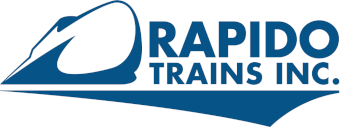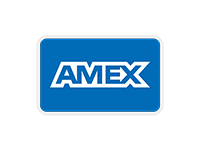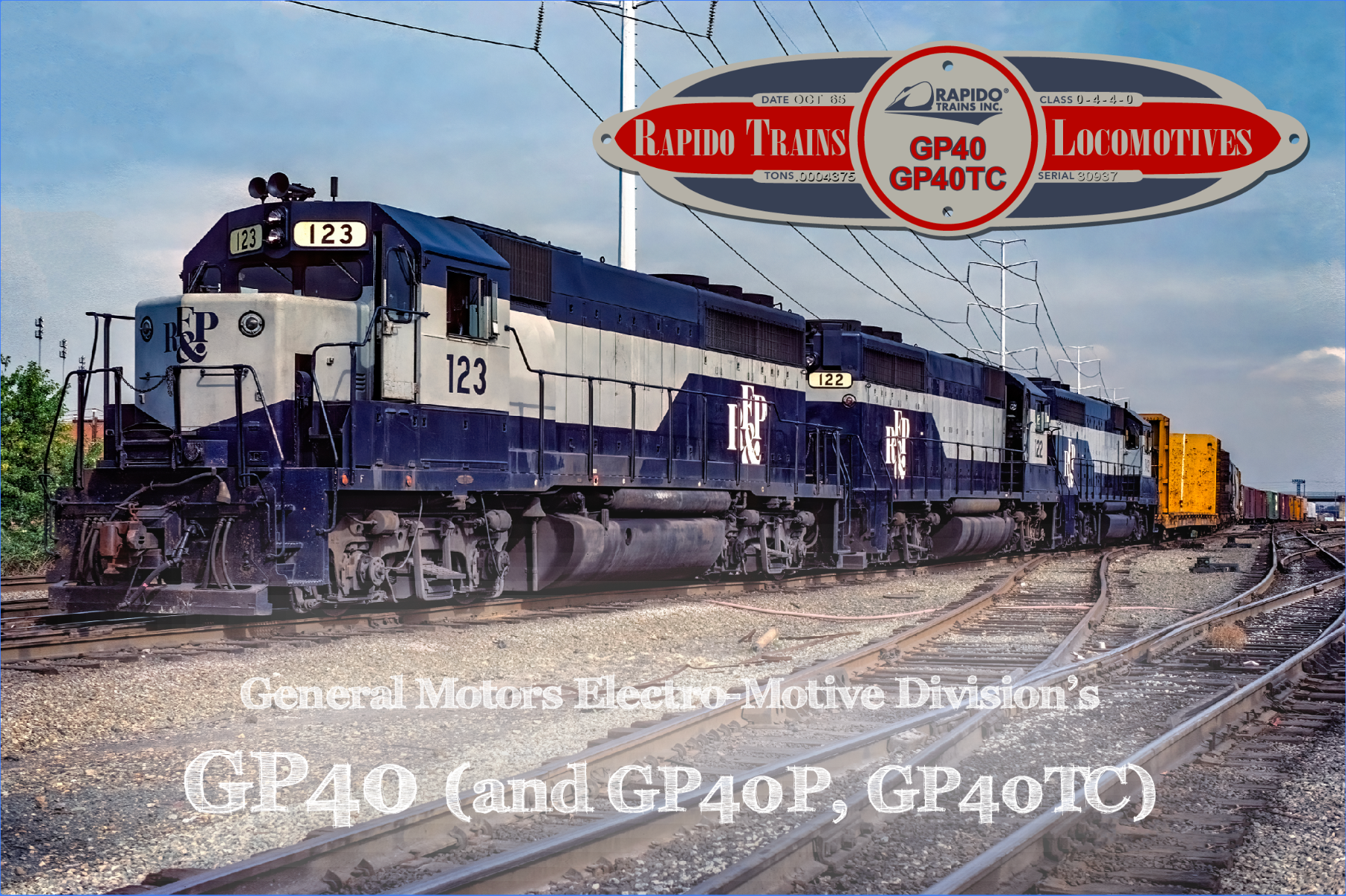
Richmond Fredericksburg and Potomac train Extra 123 South crawls out of the railroad’s "Pot Yard" (the nickname for their Potomac Yard) behind a pair of GP40s (123 and 122) and a GP40-2 (142). The RF&P operated from 1836 until 1991, when it became part of CSX Transportation. (Alexandria, Virginia – September 12, 1986)
Douglas G. Walker photograph
EMD’s GP40
(and GP40P, GP40TC and Slug)
by Craig Walker
The GP Evolution Continues … Part 2
(or … Picking Up Where We Left Off With The GP38, since we have, so far, skipped the GP39 [Send in your requests for that one!])
Part 2? But, you may be asking, didn’t the General Motors’ Electro-Motive Division (EMD) GP40s came before the GP38s? Yes, they did … feeling smug now? … But we at Rapido Trains released the GP38 first so, therefore, this is part 2 of “The GP Evolution” story … Our apologies for any confusion.
In 1965, EMD was revamping their locomotive line, and following the 2500 horsepower (hp) GP35, built from 1963 to 1965, EMD created the 3000 hp GP40. These locomotives were 3-feet longer than the GP35s, and perhaps the most obvious spotting feature was a set of three 48-inch radiator fans, rather than the GP35’s two 48” and one 36” radiator fans. If you like to count, the GP40 has ten handrail stanchions (whereas the GP35 has only nine). The side sill is also straighter, too, without the large panel for the fuel fill that was found on most GP35s. (So, if you need GP40s for your railroad, any GP35 models you have are not “close enough”.)
Built on a 55-foot frame (for the freight version), the GP40 was powered by an EMD 645E4 16-cylinder diesel engine generating 3,000 hp (2,240 kW).
As most railroads in the mid-1960s were eager for new power, and power that had a higher horsepower, the GP40 was a hit with EMD’s customers all over North America. A total of 1.221 GP40s were built from November 1965 through December 1971, when, as with many other EMD locomotives, it was replaced by the Dash 2-variant (in this case, of course, the GP40-2). Over this span, EMD built 1,187 GP40s for 28 railroads in the United States, 16 of them (at their Canadian subsidiary General Motors Diesel) for Canadian National, and 18 for two railroads in México.


With 161 units, the Baltimore & Ohio owned the second-largest fleet of GP40s. Delivered in their “buttoned down” blue and yellow paint scheme, purchased from November 1966 through November 1971. Two years later, Chessie System Inc., the holding company that owned the B&O, Chesapeake & Ohio, Western Maryland and Baltimore & Ohio Chicago Terminal Railroad, created a vivid new paint scheme, along with a very ‘70s logo, and many of the 216 GP40s operated by this corporation (“Chessie” was not a railroad per se, as all four railroads retained their names and reporting marks) were repainted into this scheme, as exemplified by B&O GP40 3690.
(Dayton, Ohio – August 18, 1985) Gregory J. Sommers photograph
As you may have already surmised, there were …
Options and Variants
The most obvious option, as with most EMD produces, was dynamic braking. (Dynamic brakes are used for improved braking on trains operating on grades by the use of an electric traction motor – the motor on a locomotive’s axles – as a generator when slowing a train and the generated electrical power is dissipated as heat in brake grid resistors. Dynamic braking reduces wear on friction-based braking components, and regeneration lowers net energy consumption.) GP40s with dynamic brakes featured a prominent bulge on the center of the long hood, with a 48” fan on top.
Another variant on GP40s, as on other diesels too, was a high short hood (also commonly called a “high nose,” although as we shall see that is not technically correct). Sixty units were built with a high short hood, and dual control stands, for the Norfolk & Western Railway. These locomotives could be operated easily in either direction thanks to the dual control stands … and thus, the term “high nose” is not accurate as the short hood isn’t always the front, or nose, of a locomotive.
Additionally, there were two passenger versions of the GP40 built as well, utilizing longer frames to accommodate the steam generator: The GP40P for Central of New Jersey’s commuter trains, and the GP40TC for Toronto’s GO Transit.
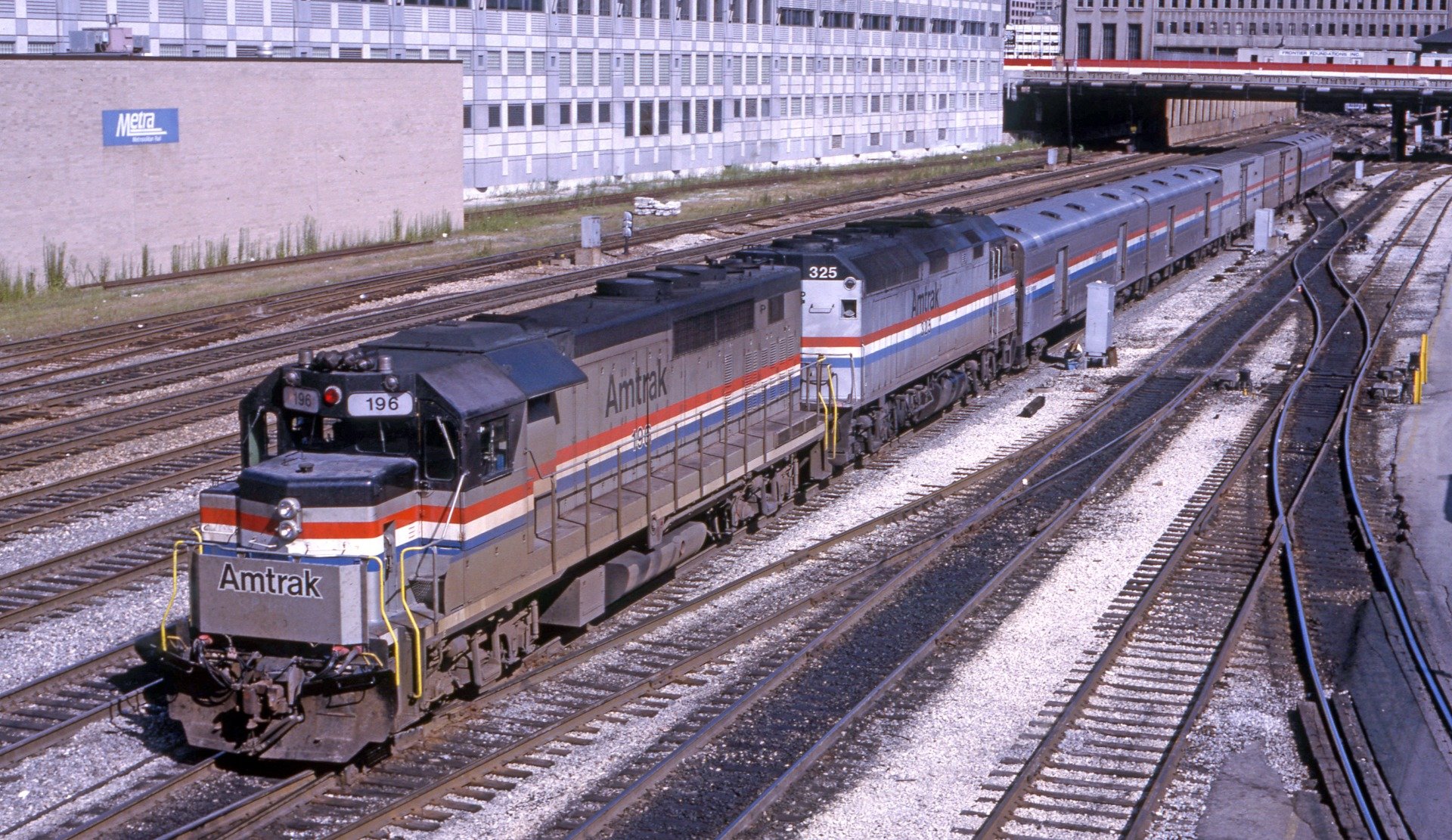

The eight GO Transit GP40TC passenger diesels were sold to Amtrak in 1988, where they were used primarily in the Chicago area and on short-haul trains. However, they turned up as far away as Los Angeles at least a few times, primarily on the late, great Desert Wind. Here is AMTK 196 shuttling some headend cars out of Chicago’s Union Station on August 30, 1992.
Jim Herold photograph, Gregory J. Sommers collection
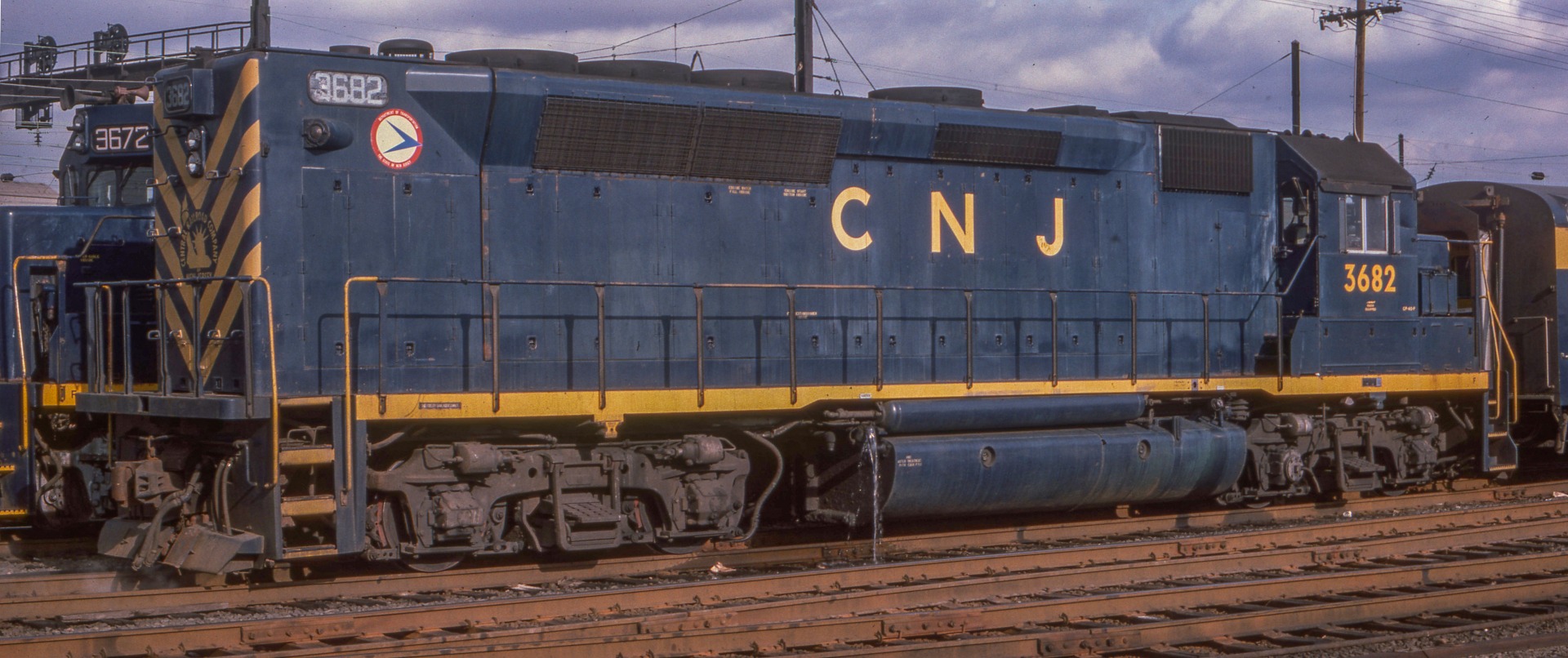

Here we see the interesting end of a GP40P, with the extension housing the steam generator. Thirteen of these were built for the Central Railroad of New Jersey. The CNJ's passenger operations were transferred to NJDOT in 1976 (with Conrail operating them under contract, with these locomotives becoming CR 4100-4112), and in 1983 New Jersey Transit assumed operating passenger rail service in the state, at which point these were numbered NJTR 4100-4112. Shortly after, the steam generator was replaced with a diesel HEP generator, and the units were reclassified as GP40PH. They would later be rebuilt as GP40PH-2 units in 1991–92. (Harrison, New Jersey – December 7, 1975)
Walter Matuch photograph, Gregory J. Sommers collection
A few other road-specific variations are shown in the photos as well.
The initial GP40 owners were:
- Atlanta & West Point – 726-732 (7 locomotives)
- Atlantic Coast Line – 915-929 (15 locomotives)
- Baltimore & Ohio – 3684-3779, 4000-4064 (161 locomotives)
- Canadian National – 4002-4017 (16 locomotives, built by GMD in London, Ontario, Canada)
- Chesapeake & Ohio – 3780-3794, 4065-4099 (50 locomotives)
- Chihuahua Pacifico (México) – 1000-1007 (18 locomotives)
- Chicago Burlington & Quincy – 170-189, 620-639 (40 locomotives)
- DeQueen & Eastern – D-7 (1 locomotive)
- Denver Rio Grande & Western – 3051-3093 (43 locomotives)
- Detroit Toledo & Ironton – 400-405 (6 locomotives)
- Florida East Coast – 401-410 (10 locomotives)
- Georgia Railroad – 751-754 (4 locomotives)
- Illinois Central – 3000-3074 (75 locomotives)
- Louisville & Nashville – 3000-3029 (30 locomotives)
- Milwaukee Road – 153-199, 2047-2071 (72 locomotives)
- Missouri-Kansas-Texas – 170-230 (61 locomotives)
- Nacionales de México – 8400-8409 (10 locomotives)
- New York Central – 3000-3104 (105 locomotives)
- Norfolk & Western – 1329-1388 (60 locomotives)
- Penn Central – 3105-3274 (170 locomotives)
- Richmond Fredericksburg & Potomac – 121-127 (7 locomotives)
- Rock Island – 340-396, 4700-4719 (77 locomotives)
- Saint Louis-Southwestern (Cotton Belt) – 7600-7607 (8 locomotives)
- Seaboard Air Line – 600-650 (51 locomotives)
- Soo Line – 732-735 (4 locomotives)
- Texas Oklahoma & Eastern – D-12 – D-14 (3 locomotives)
- Toledo Peoria & Western – 1000 (1 locomotive)
- Western Railway of Alabama – 701-707 (7 locomotives)
- Western Maryland – 3795-3799 (5 locomotives)
- Western Pacific – 3501-3544 (44 locomotives)
GP40P:
Central Railroad of New Jersey – 3671-3683 (13 locomotives)
GP40TC:
Canadian National (for GO Transit) – 600-607 (8 locomotives)
Subsequent GP40 owners include those acquired through mergers (such as Alaska Railroad, Allegheny Railroad, Amtrak [GO Transit’s GP40TCs], Boston & Maine, Burlington Northern, BNSF Railway, Conrail [include the CNJ’s GP40Ps], CSX Transportation, GO Transit [the CN’s GP40TCs], Illinois Central Gulf, Kansas City Southern, NJ Transit [the CNJ/CR GP40Ps], Norfolk Southern, Seaboard Coast Line, Seaboard System, Soo Line [ex-MILW], Southern Pacific and Union Pacific), as well as sales to leasing companies (such as HLCX and LLPX) and second-hand sales to other railroads and shortlines (such as Arizona & California, Central Oregon & Pacific, Central Vermont, Chicago & North Western, Fort Worth & Western, Grand Truck Western, Maine Central, New England Central, Ohio Central; Paducah & Louisville, Santa Fe, Vermont Railway and Wisconsin Central among others).
GP40 Fun Facts! (…And esoterica):
- New York Central 3036 was the first GP40 built.
- Chesapeake & Ohio 3794 was the last GP40 built.
- Milwaukee Road 2068-2071, Penn Central 3260-3274 and Toledo Peoria & Western 1000 were EMD warranty loaners.
- Penn Central bought more than any other railroad – 170! (And, through the NYC-PRR-NH merger, then ended up rostering NYC’s GP40s for a total of 275!!!)
- DQE and Toledo Peoria & Western each purchased just a single GP40.
- Thanks to a power shortage on the Atchison Topeka & Santa Fe Railway in the late 1970s, a slew of surplus Baltimore & Ohio and Chesapeake & Ohio GP40s were leased. Many of these were quasi-renumbered by the ATSF, with a 9 replacing the 3 in the roadnumber – B&O 3686, therefore, became 9686. These locomotives were split fairly evenly between B&O/C&O blue and yellow, and units wearing Chessie System colors.
- While the Atchison Topeka & Santa Fe never purchased any new GP40s, they did end up with Toledo Peoria & Western’s lone GP40 when ATSF acquired the TP&W. ATSF spent time rebuilding it, and even added dynamic brakes to it. It was released for service from the San Bernardino CA Shops in August 1984, and then destroyed in a wreck in Pico Rivera CA on January 22, 1988.
- Baltimore & Ohio 3684 has been added to the collection of the B&O Museum in Baltimore, restored to B&O paint.


The Atchison Topeka & Santa Fe Railway elected to pass on the GP40, instead purchasing 61 GP38s to supplement all the SD39s, SD40s and SD45s (among other 6-axle diesels) they rostered. The midwestern Toledo Peoria & Western Railway was merged into the ATSF at the end of 1983, their lone GP40, TPW 1000 (the former EMD demonstrator 21) was sent to San Bernardino CA for rebuilding into ATSF 3461 and later ATSF 2964.
(San Bernadino, California – April 12, 1985) Craig Walker photograph
On The Job
Nearly six decades after the first GP40 emerged from EMD’s factory in suburban Chicago, paving the way for another thirty years of Geeps, GP38s are still plying rails all over North America, hauling tonnage on shortlines, regionals and Class 1 railways. The GP40 and its brethren were soon found on nearly all major, minor and railroads in-between within a few years of their debut. They were found on mainline manifests, branchline locals, transfers and yard jobs. GP38s worked trains by themselves, or were teamed with other GP40s, older GPs (GP7s, GP9s, GP30s, GP35s, etc.), six-axle diesels, newer Dash 2 locomotives, General Electric and ALCO diesels, older end cab switchers – GP40s were up for any task their railroads gave them! They were, indeed, dependable workhorses!
As time passed, many GP40s were upgraded to GP40-2 specifications, and reclassed as such even though externally they are still GP40s in appearance, as they lack the Dash 2 spotting features. Other railroads downgraded their GP40s to GP38-2 standards, often (but not always) removing the center radiator fan. Still other railroads converted some of their GP40s to slugs, quasi-locomotives powered with axle-mounted electric motors, but lacking a diesel engine and coupled to another diesel from which it would get electrical power, and often (but, again, not always) with a rebuilt carbody (usually with no cab and a much lower hood) – essentially creating an eight-axle locomotive that uses less fuel and can easily negotiate curves (thanks to being, as it were, articulated).


A lot of power, in the form of five Missouri-Kansas-Texas GP40s and one former GP40 converted into a slug, works a train in Council Bluffs. Slugs have traction motors on their trucks’ axles, but there is no diesel engine to generate the needed electricity – instead, the slug has extra weight to provide adhesion on the rails. Electricity is provided by at least one of the GP40s.
(Council Bluffs, Iowa – May 1984) George Cockle photograph, Gregory J. Sommers collection
Variations …
We Know You’re Shocked That There Are Variations
As with so many locomotives, there were a number of variations, often due to their owners’ preferences, such as short hood (aka “nose”) heights, lighting options, etc.
Here is a list of many of these options and variations:
- A wide variety of air horns, snowplows, bell styles (and placement) were found on GP40s. Checking photos is advisable.
- Perhaps the most obvious variation on GP40s is the presence, or absence, of dynamic brakes and the resultant bulges on the long hood. A few GP40s had their dynamic brakes removed, with the d/b bulges’ grilles blanked over. And, other times, dynamic brakes were added, as happened when Santa Fe acquired TP&W’s only GP40 (and it became ATSF’s only GP40) and added dynamic brakes to it.
- The earliest GP40s were constructed with the early-style radiator fans (with a “pan” in the center), and at some point the newer fans, without the “pan”, were installed. This also applies to dynamic brake fans, should a locomotive be so equipped.
- There were at least three different stepwells used on GP40s:
- The standard version and the version often known as the “switcher” version, which has a more vertical step arrangement to allow a crewman to comfortably – and safely – stand on the bottom step when switching cars. Santa Fe and Burlington Northern GP38s featured this option. (So, that’s two, combined into just one bullet point! Why? Just to confuse you…)
- Canadian Pacific’s GP38s, having been constructed at GMD in Canada, were built with Canadian-style stepwells.
- Fuel tanks were ordered in a variety of sizes, determined by the type of service in which a railroad’s locomotives would be assigned.
- Battery box covers varied somewhat in design, with variations of louvers, bolt patterns and, on B&O/C&O units, slots for enhanced cooling.
- While all GP40 locomotives were delivered with class lights, as time progressed and they were no longer deemed necessary they were removed and replaced by gasketed blanks, plated over or neatly and smoothly filled in.
- As usual, Norfolk & Western, specified high short-hoods (commonly called “high-noses”) on their GP40s. Along with this option, they also had the control stands installed on the opposite side of the cab in order to operate their GPs in either direction, including long-hood forward.
- As might be expected, there were a few lighting options on GP40s. Most were built with a twin sealed-beam headlight between the cab’s numberboards, but a few were delivered with other variations:
- Cotton Belt’s GP40s featured all the distinctive lighting specified for parent company Southern Pacific’s diesels: Dual Gyralights on the cab, between the numberboards, and a single red Gyralight in the nose, above the horizontally mounted twin sealed-beam headlight.
- Denver & Rio Grande Western’s GP40s, as with their other hood diesels, were built with a twin-Mars signal lights in the nose. However, some later units may have been delivered with Pyle lights, and as Mars lights failed many were replaced with Pyle lights.
- Western Pacific GP40s 3501-3516 were built with large single-bulb Pyle headlights between the cab’s numberboards and a similar Pyle “barrel” light on the rear. This large headlight was later removed and a twin sealed-beam headlight installed on the large area that used to house the single-bulb headlight.
- Western Pacific GP40s 3517-3544 were built with a twin-Pyle signal lights in the nose.
- As visibility and safety requirements changed, ditchlights were added to these locomotives.
- Detroit Toledo & Ironton’s GP38ACs were delivered with gong bells applied to to their low short-hoods (aka “noses”).
- Some late production GP40s, such as those purchased by Western Maryland, were constructed with ribbed blower housings, typically a spotting feature on GP40-2s but actually introduced in mid-1971, six months before the Dash 2 line was introduced.
- Disclaimer: Many of the parts were interchangeable, and as individual locomotives were serviced (or rebuilt following minor skirmishes with forces beyond normal wear and tear – that is, accidents) parts were often switched, resulting in a locomotive with mixed early and late fans, or battery box covers were changed, solid bearing trucks could end up with different styles of journal housings, et cetera. And, for additional fun, often the paint on these parts didn’t match, either. Of course, changes to rules or other requirements would result in changes, too, such as the removal of class lights in a variety of ways (as mentioned earlier … Don’t make me repeat myself!). This is all part of the fun of modeling a fleet of locomotives – the variations, often subtle and other times painfully obvious, over time give each locomotive a personality.
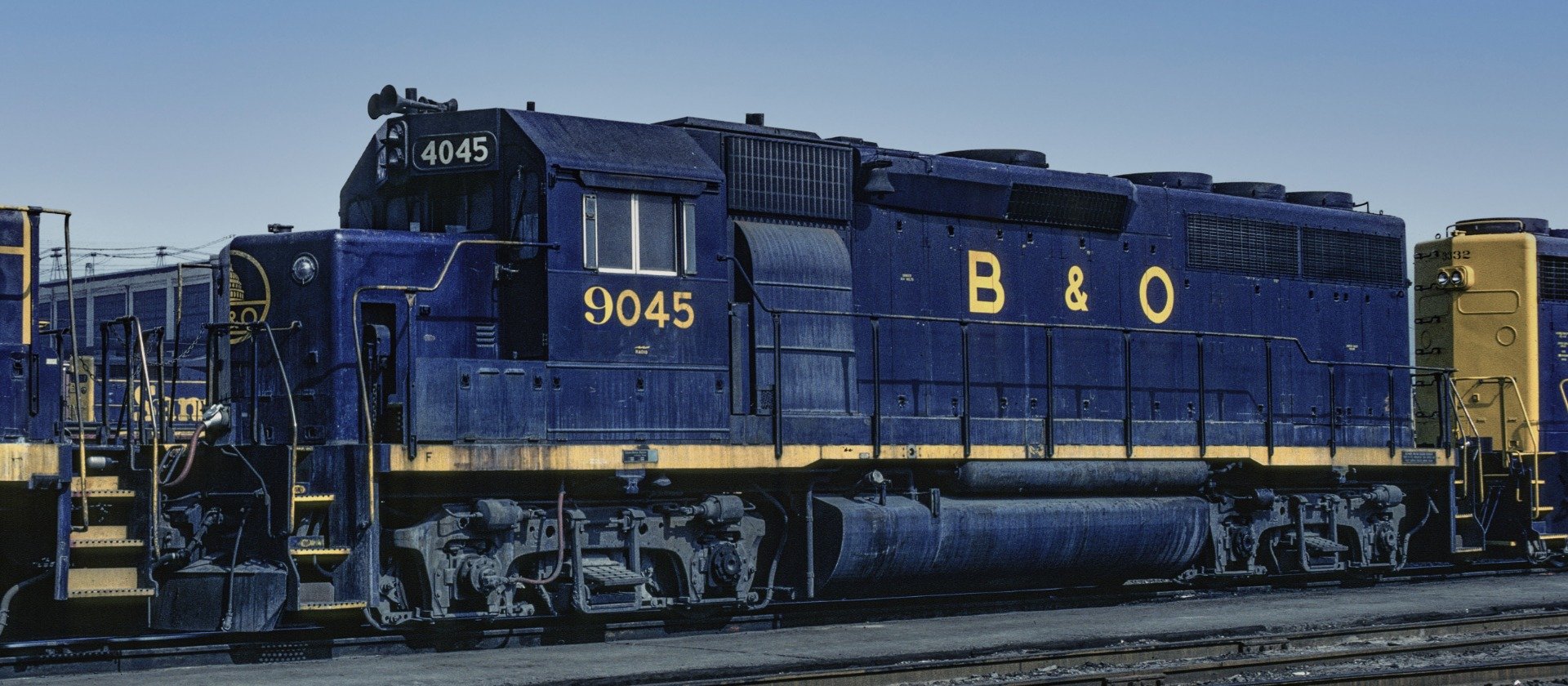

The Chessie System roads (B&O, C&O and WM) owned so many GP40s that many of them were leased to other railroads from time to time. (And quite a few of the Chessie’s GP38s and GP40s were found in Calgary, Canada, in the 80s on the Canadian Pacific.) In the late 1970s, the Atchison Topeka & Santa Fe Railway was short of power, and signed a short-term lease with Chessie System Inc. to operate a number of B&O and C&O Geeps for a few years, with the vast majority being GP40s. Curiously, the ATSF changed the first digit of the roadnumbers on these to a “9” to avoid any confusion. The number was changed only the cab sides, using a distinctly “Santa Fe-ish” numeral, leaving the numberboards untouched. It was a fun time to railfan the Santa Fe, though. The blue units kind of blended into the ATSF’s fleet – kind of – while those diesels wearing the bright Chessie System scheme screamed “Look at me!”
(San Bernadino, California – April 12, 1985) Craig Walker photograph
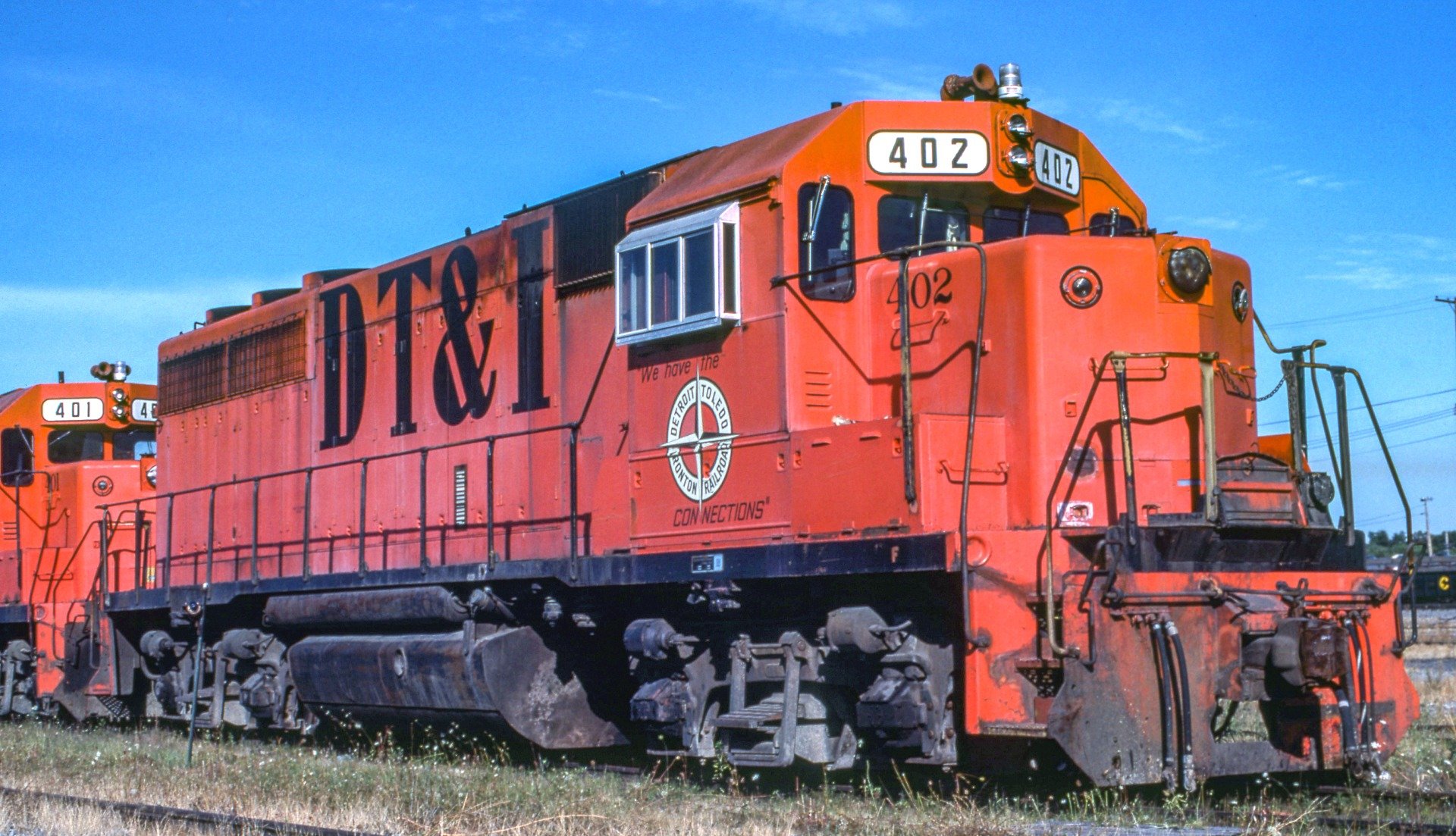

Detroit Toledo & Ironton’s GP40s, such as DT&I 402, had nose bells on their short hood.
(Flat Rock, Michigan – August 29, 1982) Jim Claflin photograph, Gregory J. Sommers collection
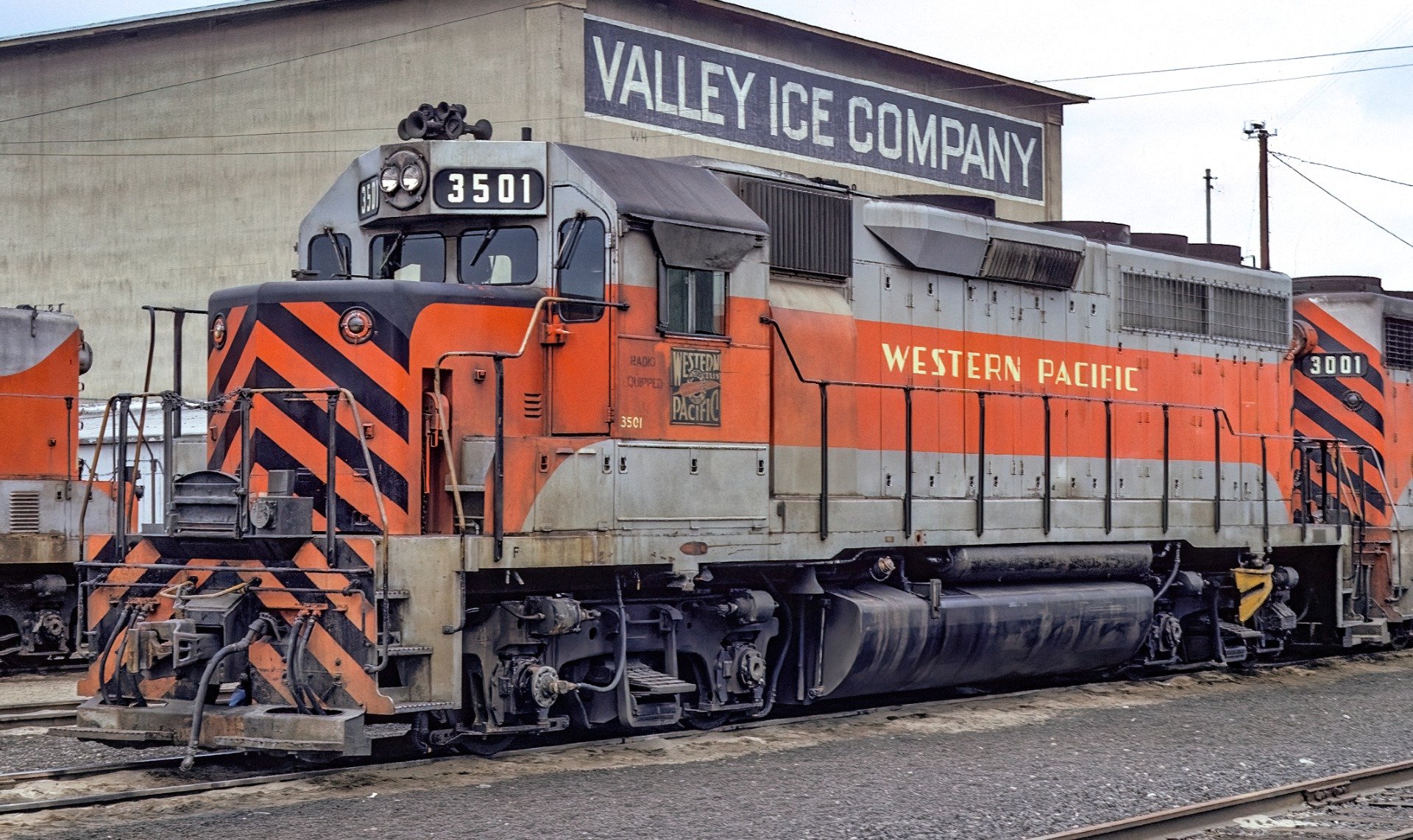

A trademark of many Western Pacific EMD locomotives was their distinctive headlights. WP GP40 3501, photographed in 1972, has the non-standard numberboards on the cab to allow for a large, circular headlight. These were later replaced, as seen here, by twin sealed-beam headlights, but on a disc fitted into the large headlight opening. And also check out the large, “can” headlight on the rear of WP 3001 coupled behind it, as that is the same headlight on the rear of the early GP40s, such as 3501, as well.
Peter Arnold photograph


The Southern Pacific Railroad was well known (and loved) partly because of their unique lights on their diesels. While the SP never rostered a GP40, their subsidiary St. Louis-Southwestern (more popularly known as the Cotton Belt) did order eight of these diesels. And they were delivered with the same distinctive light packages as was found on the parent company’s power: A gyrating signal light on the cab, a red gyrating light on the top of the nose, and a horizontal twin sealed-beam headlight under that. Curiously, the then-standard SP L-windshield (to improve the engineer’s view out the front) was not included on this order.
Tim Dickinson photograph, Gregory J. Sommers collection
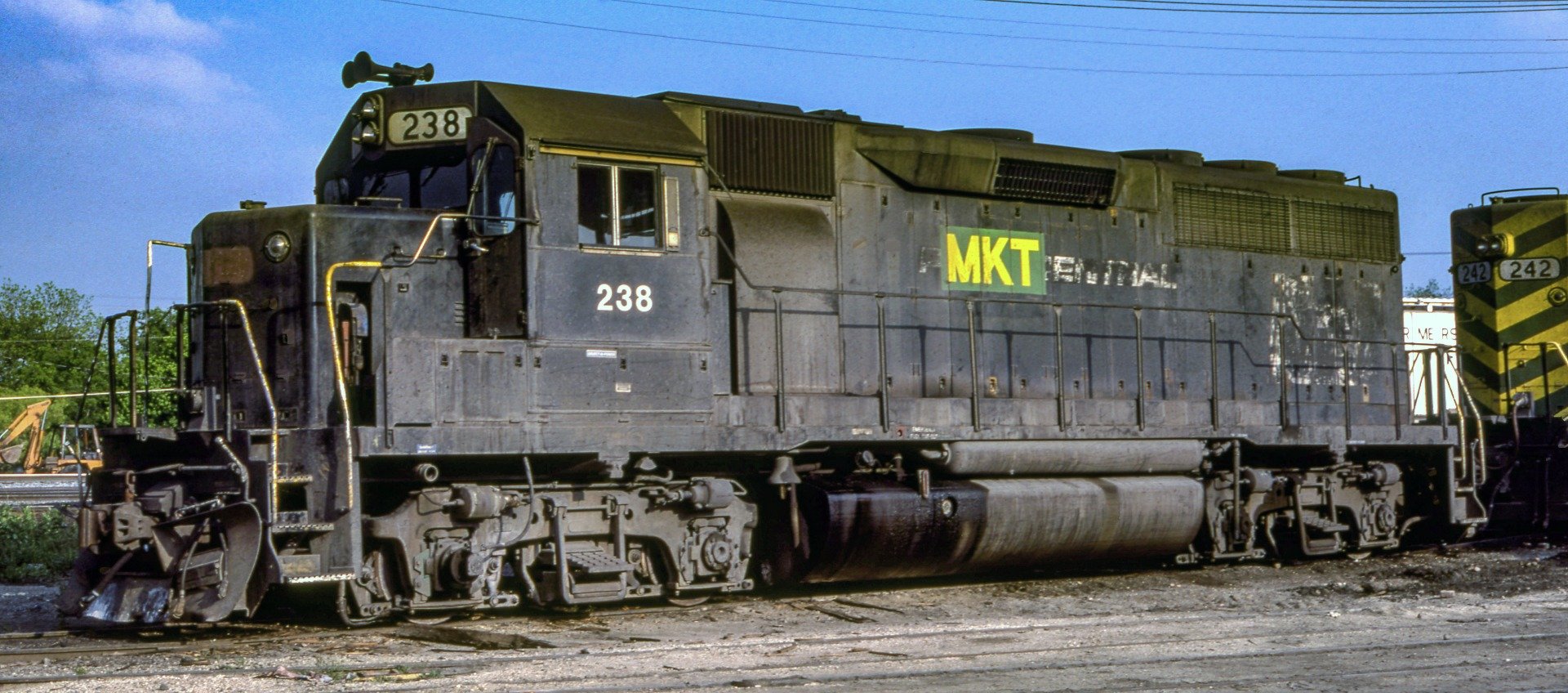

Penn Central owned the largest fleet of GP40s, which of course later became Conrail locomotives. As CR purchased newer power, their fleet of GP40s were often sold to other railroads, as exemplified by Missouri-Kansas-Texas 238, still wearing the colors of Penn Central but with a colorful MKT patch on its flanks and a new three-digit roadnumber. This is a testament to the ubiquitousness of the EMD GP40! (Fort Worth, Texas – April 13, 1986)
Jim DeNike photograph, Gregory J. Sommers collection
|
Thanks to Peter Arnold and Gregory J. Sommers for their assistance!
